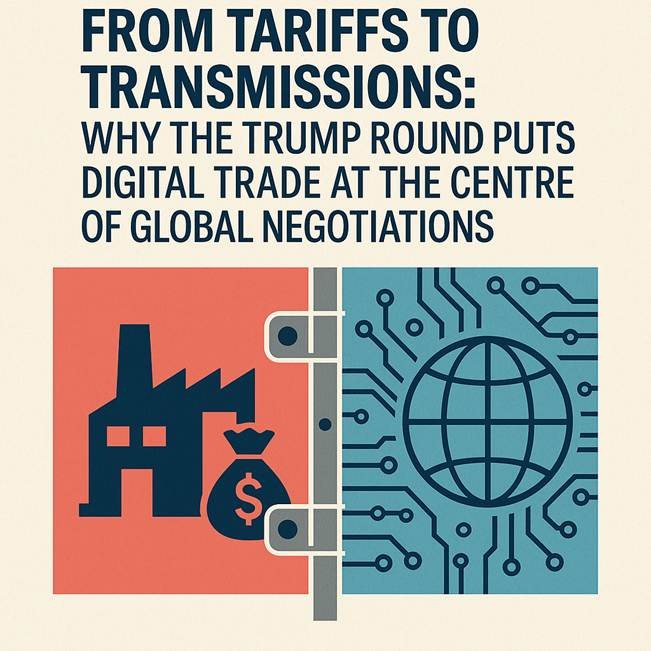From Tariffs to Transmissions:
Why the Trump Round Puts Digital Trade at the Centre of Global Negotiations
From Tariffs to Transmissions: Why the Trump Round Puts Digital Trade at the Centre of Global Negotiations
By Prof. Barry Appleton
Appleton’s Clause & Effect Blog – August 21, 2025 ⏱ ~5min read
The ink is barely dry on the August 21, 2025, US-EU "Framework Agreement on Reciprocal, Fair, and Balanced Trade,"1 and already the financial press has dismissed the joint statement as mere tariff tinkering.
Don't be fooled.
This is not a technical adjustment. It is the opening salvo in what must now be recognized as the Trump Round of global trade negotiations. Unlike previous rounds organized in Geneva, this one is conducted through bilateral leverage and digital ambition. And its center of gravity is unmistakable: digital trade now defines the terms of market access, sovereignty, and security. It is not just tariffs anymore. Canada saw this in the demands to withdraw its digital sales tax in June, to have trade talks continue. The EU considers this digital trade dimension at the heart of the trade talks now.
Four Digital Clauses in the deal That Just Rewrote Constitutional Power
Clause 15: Intellectual Property
IP commitments once protected patents and trademarks. Today, they secure algorithmic models and proprietary APIs. By embedding "high-standard commitments" into treaty law, Washington and Brussels transform code into an enforceable sovereign asset.
Clause 17: Digital Trade Liberalization
By pledging to uphold the WTO moratorium on customs duties for electronic transmissions and rejecting "network usage fees," the U.S. and EU have declared digital flows untaxable. This is not deregulation; it is jurisdictional consolidation. For middle powers seeking fiscal sovereignty, it forecloses vital options.
Clause 18: Customs Digitization
Europe will consult U.S. traders on its customs reform. Once compliance systems are algorithmically embedded, consultation becomes co-regulation. Whoever writes the interface writes the border.
Clause 19: Economic Security
Supply chain resilience, investment screening, and export controls are now fused into the trade agenda. The language of comparative advantage has been replaced by the grammar of technology alignment. This is a like a digital NATO clause, positioning trade as an instrument of collective security.
The New Reality: Code Before Clause
Digital trade agreements are no longer commercial annexes. They are constitutional documents that decide who governs data, infrastructure, and algorithms.2
The lesson is simple: if code precedes law, then sovereignty must precede treaties.
Without domestic legislation including a Digital Sovereignty Act, an Algorithmic Accountability Act, or a credible audit capacity, Canada risks importing foreign architectures by default. Once embedded in a binding treaty, they will not be easily unwound.
Why This Is The Trump Round—And Why It Matters
The Trump Administration has fused digital trade with its industrial and security strategy. Commitments on semiconductor supply chains, AI chips, and algorithmic alignment now sit alongside tariff concessions on steel and automobiles. This round is not about tariffs; it is about technological command.
If the GATT Uruguay Round institutionalized services and the WTO Doha Round faltered on agriculture, the Trump Round is consolidating digital rules as the new frontier of trade law. The WTO moratorium on electronic transmissions, once foolishly considered an obscure footnote, has become the pivot of global governance and economic power.
Canada's Dangerous Game of Digital Catch-Up
Canada enters this round without a coherent digital sovereignty framework. We lack both an AI Act and a Digital Sovereignty Act, and we also lack the institutional capacity to audit algorithmic governance. The U.S. brings extraterritorial tools such as the CLOUD Act; the EU brings its GDPR, AI Act, and Digital Services Act. Canada brings consultations.3
The asymmetry is dangerous. Unless Ottawa legislates first, Canada will negotiate from dependency, not parity.
The Constitutional Question We Can't Ignore
To paraphrase what trade law scholar Ernst-Ulrich Petersmann observed, law is not only about market access but also about who writes the constitution of the economy.4 Today, that constitution is being drafted in Washington and Brussels. If Canada continues to delay, it will not be among the drafters. It will be among the rule-takers.
The Trump Round has placed digital trade at the centre of global negotiations. Canada must be ready. First, Canada needs to have a coherent and cohesive domestic digital sovereignty framework and build the governance capacity to implement it. That means we need to legislate before we negotiate. Otherwise, Canada risks becoming a tenant in its own digital democracy.
Canada Briefing: Preparing for the Trump Round
Key takeaways for policymakers
1. Legislate first. Pass a Digital Sovereignty Act to establish authority over data, AI, and digital infrastructure before binding international commitments.
2. Build capacity. Establish an independent Digital Governance Agency with technical audit powers for algorithms, cloud, and AI systems.
3. Negotiate reciprocity. Any digital trade agreement must recognize Canadian standards (e.g., CAN/DGSI, AI Directive) as equivalent, not subordinate, to EU or U.S. frameworks.
4. Adopt digital non-alignment. Preserve Canada’s right to engage with multiple systems while retaining independent regulatory sovereignty.
5. Anchor sovereignty. Embed a “public interest supremacy clause” in any agreement, ensuring democratic oversight cannot be subordinated to corporate secrecy.
Endnotes
Joint Statement on a United States-European Union Framework on an Agreement on Reciprocal, Fair, and Balanced Trade, The White House (21 August 2025), online: The White House <https://www.whitehouse.gov/briefings-statements/2025/08/joint-statement-on-a-united-states-european-union-framework-on-an-agreement-on-reciprocal-fair-and-balanced-trade/>.
Barry Appleton, Algorithmic Empire and the New Digital Colonialism: The Legal Struggle for Technological Self-Determination in the Age of AI (12 August 2025), online: SSRN <https://ssrn.com/abstract=5389292> or <http://dx.doi.org/10.2139/ssrn.5389292>.
Global Affairs Canada has announced a consultation on an exploratory Canada-EU Digital Trade Pact that runs until August 25, 2025. https://international.canada.ca/en/global-affairs/consultations/trade/2025-06-23-digital-trade. My views are set out in an upcoming paper. See Barry Appleton, Code Before Clause: Building Canada’s Digital Defences Before Negotiating Trade (Waterloo: Balsillie School of International Affairs, August 2025) [forthcoming Balsillie Paper].
Ernst-Ulrich Petersmann, Constitutional Functions and Constitutional Problems of International Economic Law (Fribourg: University Press, 1991) at 45.


